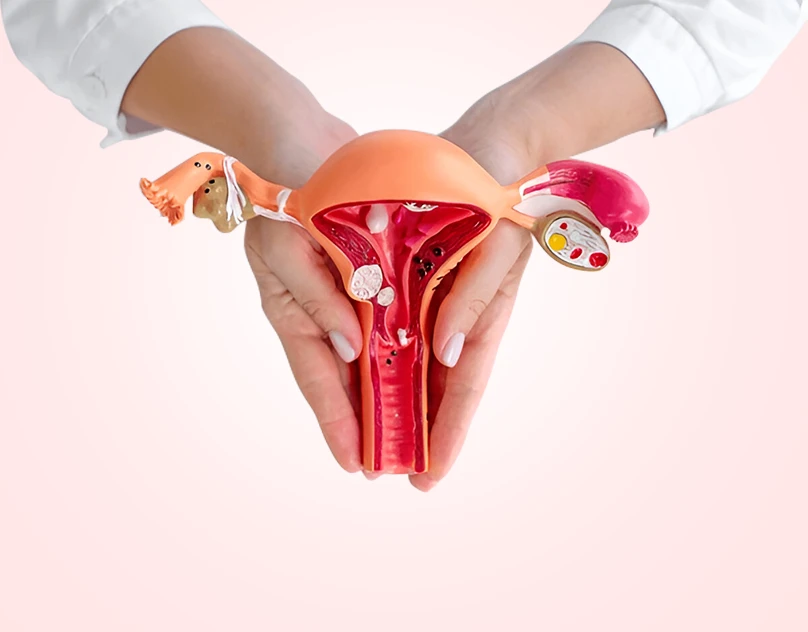

Actionable Tips How To Prevent Endometriosis
Endometriosis is a condition where tissue which are like the lining of the uterus, endometrium, grows outside of it. This misplaced tissue on the ovaries, fallopian tubes, and some other pelvic organs, and sometimes even in more distant parts of the body, might be developed. Knowing how to prevent endometriosis can help to work on the issue effectively
Like the uterine lining, this tissue shall thicken, breaking down, and bleeding with each menstrual cycle. However, but with no way for the blood to leave the body, it can lead to severe pain, inflammation, scarring, and even infertility in some situations. While the exact cause of the condition endometriosis is not fully known, and there is no guaranteed way to prevent it entirely. Further to understand the risk factors and adopting certain lifestyle choices can significantly lower the chances of developing or worsening such issues.
Understanding Endometriosis Briefly
Endometriosis affects approximately. 1 in 10 women from around the world have this during their reproductive years. Along with certain individuals experiencing debilitating pain and others having no symptoms at all. Some of the common
- Painful periods (dysmenorrhea): These are more common than menstrual cramps.
- Chronic pelvic pain: Persistent ache in the lower abdomen and pelvis.
- Pain while or post sex
- Pain with bowel movements or urination
- Heavy bleeding during the menstrual cycle
- Infertility: Endometriosis is a condition that makes it harder to achieve pregnancy
- Other symptoms: Fatigue, diarrhoea, constipation, bloating, or nausea, might occur too
The exact mechanisms that can lead to endometriosis are still being researched. However, there are various theories that do exist. One common is about retrograde menstruation, where menstrual blood containing endometrial cells flows back through the fallopian tubes and into the pelvic cavity.
These cells might attach to organs and grow. Some other theories do involve immune system issues, genetic predisposition, and alterations in embryonic cells.
Factors That Influence Endometriosis Risk
While preventing endometriosis condition, doing it completely is not always possible. There are various factors which have been all identified that can either enhance or lower those risk.
- Family history: The risk of having endometriosis can enhance if you have a mother, sister, or daughter with this same condition.
- Early menstruation: Girls whose periods have been started before the age of 11 years.
- Short menstrual cycles: To women whose cycles are particularly less than 27 days.
- Heavy and long periods: Periods that are lasting longer than seven days for some women.
- Never having given birth
- Higher levels of estrogen: Or some greater lifetime exposure to some specific estrogen levels
- Having a notable Low body mass index (BMI)
- Any health condition that might prevent blood from flowing out of the body while being on menstrual periods.
- Being pregnant and breastfeeding
- Having the first period post 14 years of age
- Eating fruits that has citrus
Lifestyle Choices for Tips on How To Prevent Endometriosis
While there is no magic bullet, which is a holistic approach that shall focus on diet, exercise, and environmental awareness. Things that can play a significant role in managing risk factors with reference to how to prevent endometriosis can potentially lower the severity of endometriosis.
Dietary Modifications, Eating for Hormonal Balance and lowered Inflammation
Diet is known to play a crucial role in managing inflammation and some sort of hormonal balance. Some of both of which are key in endometriosis like condition. An anti-inflammatory diet that is rich in some nutrients can be very well beneficial.
Foods to Embrace:
- Fiber-rich foods: This can worsen endometriosis symptoms. Further, you are to include raw or boiled fruits and vegetables, legumes (like components beans, lentils, chickpeas), whole grains (whole-wheat pasta, brown rice), and some ground flaxseed.
- Omega-3 fatty acids: These “good fats” are known as some powerful anti-inflammatory agents. These are excellent source in fatty fishlike salmon, sardines, and tuna, as well as plant oils like flaxseed oil and canola oil, and nut.
- Monounsaturated fats: Also possessing anti-inflammatory properties, they are known to be found in olive oil, avocados, nuts, and seeds.
- Minerals like magnesium and zinc: Magnesium helps in relaxing muscles and regulating those menstrual cycle. Some good sources like dark chocolate (in moderation), legumes (black beans), leafy greens (spinach), and nuts and seeds. Zinc is known to be found in crabs, chicken, oysters, and lobsters.
- Antioxidant-rich fruits and vegetables: Some of the berries, leafy greens (spinach, kale), and cruciferous vegetables are known to be packed with antioxidants which shall combat oxidative stress and some sort of inflammation.
- Turmeric and ginger: These known spices are to have strong anti-inflammatory properties.
Foods to Limit or Avoid:
- Red and processed meats: They are high in saturated fat that can promote inflammation and enhance estrogen level.
- Processed foods and sugary snacks: Containing high levels of sugar, unhealthy fats, some artificial additives. They are to contribute to inflammation and further it can worsen hormonal imbalances.
- Dairy products: Some individuals are to find dairy products that can worsen bloating and digestive discomfort associated with endometriosis condition. While there is more research that is needed, plant-based alternatives can be considered while you notice some link.
- Caffeine and alcohol: It can contribute to enhanced estrogen levels and inflammation. Moderation is the key, and some individuals might further find it shall be all beneficial to lower those eliminate them.
- Trans fats: Found in processed and some sort of fried foods. They are highly inflammatory.
Regular Physical Activity, Helps With Moving for Wellness
Performing exercises regularly can help in managing endometriosis by lowering those estrogen levels. This also helps in promoting endorphin release (which shall be about natural painkillers) and enhance overall circulation.
- Moderate-intensity aerobic activity: Go got 150 minutes activity per week. This can further include acts like cycling, brisk walking, swimming, or light yard work. Some of these activities can help in sustaining a healthy body fat percentage. This can contribute to lower circulating estrogen.
- Yoga and stretching: It can help in improving flexibility, lowering muscle tension, and alleviate pelvic pain. Some specific yoga poses and pelvic floor exercises that can strengthen core and pelvic floor muscles. They are all affected in endometriosis.
- Strength training: It can help in enhancing posture and having great support fof the pelvic floor muscles.
It is also important to listen to the body and choose to perform exercises that do not worsen those pain. Some of the individuals might also find intense physical activity to exacerbate such symptoms.
Stress Management, By Calming the Body and Mind
Condition such as chronic stress can worsen endometriosis symptoms. It shall enhance the cortisol levels. It further leads to hormonal imbalances and heightened pain sensitivity. Incorporating some of such mentioned stress-reducing practices is needed.
- Mindfulness and meditation: Practices such as deep breathing exercises and condition of meditation can further calm the nervous system.
- Journaling: You can all help to process emotions and lower those mental loads like condition.
- Therapy or counselling: You are to seek professional support that can provide coping mechanisms and some sort of emotional support too.
- Adequate sleep: Get a quality sleep of 7 to 9 hours per night. This is needed for overall health and managing some sort of inflammation if occurred. Establish a consistent sleep schedule which shall also help in creating a relaxing bedtime routine.
- Warm baths and heating pads: Applying proper heat to the pelvic area can further relax those muscles and provide complete pain relief.
Limiting Environmental Toxin Exposure
Growing some sort of evidence can suggest a link that lays between exposure to some environmental toxins. This goes particularly well for endocrine-disrupting chemicals (EDCs), and it can enhance the risk or severity of endometriosis.
EDCs like condition can further mimic or interfere with hormones. It shall affect the body’s delicate balance.
- Identify and lower exposure to EDCs: These conditions can be found in plastics (BPA, phthalates), pesticides, and some household products.
- Food storage: Opting for some glass or stainless steel which shall be about containers instead of those plastic.
- Personal care products: You are to choose organic or natural skincare and makeup for minimizing exposure to certain synthetic chemicals.
- Cleaning products: Use some of the non-toxic and natural cleaning alternatives.
- Diet: You are to choose organic produce whenever possible. This can help to lower pesticide exposure and be mindful of where your animal products come from. Those dioxins can accumulate in fatty foods.
LifeCode’s Genetic Testing in Endometriosis Prevention
Endometriosis is known to have a strong genetic component. This means it might run in families. When your mother, sister, or daughter might have endometriosis, the risk of developing such condition is significantly higher. Also know how to prevent endometriosis so that it helps to deal with the issue well.
This hereditary nature is not due to a single “endometriosis gene” but rather might be due to a combination of multiple genes (polygenic). This shall be about interacting with several environmental and lifestyle factors (including multifactorial).
While there is absolute no single magic bullet to entirely prevent endometriosis. You are to understand the risk factors and making conscious lifestyle choices. It can further significantly influence likelihood of developing the condition or managing severity of the issue.
Adopting an anti-inflammatory diet, which shall be about engaging in regular physical activity. It helps in managing stress effectively. Further it can lower exposure to environmental toxins. They are about empowering steps to take for health.
Furthermore, recognizing the role of genetic predisposition through discussions with the healthcare provider and potentially exploring genetic testing. It can provide valuable insights for some personalized prevention strategies and those early intervention.
Take Control of Your Health with Lifecode
Understanding genetic makeup can be a powerful first step in proactive health management, especially for conditions including endometriosis. It shall all have a hereditary link.
LifeCode offers genetic test under panel at Advanced Genetic Testing for Women’s Health which can empower to make informed decisions about the well-being. By providing comprehensive and accessible genetic testing, LifeCode can help by understand the predispositions and guide towards a healthier future while knowing how to prevent endometriosis.
You are to explore services today to unlock personalized health insights and take charge of health journey.

Can You Inherit Migraine Risk The Truth About Women’s Brain Health
Can You Inherit Migraine Risk The Truth About Women’s Brain Health The Genetic Link to Migraines, It Is More Than Just Bad Luck Why Women are More...


Unlocking Your Body’s Blueprint: Genetic Clues to Pregnancy Complications and Hypertension
Unlocking Your Body's Blueprint: Genetic Clues to Pregnancy Complications and Hypertension The Intricate Dance of Genes and Health Decoding Pregnancy Complications Through Genetics The Genetic Roots of...

Education: Bachelor of Pharmacy (B.Pharm) from the Tata Institute of Social Sciences (TISS), Mumbai Experience: Agarwal is a seasoned pharmacist with over 7 years of experience in the pharmaceutical field. She has worked in various settings, including hospital pharmacies and community clinics, where she has excelled in medication management, patient counseling, and clinical support. Agarwal is known for her expertise in drug therapy optimization and patient safety. In addition to her practical experience, she contributes to health journalism, focusing on pharmaceutical advancements and health policy, and is involved in research projects aimed at improving medication practices and health outcomes. is known for her expertise in drug therapy optimization and patient safety. In addition to her practical experience, she contributes to health journalism, focusing on pharmaceutical advancements and health policy, and is involved in research projects aimed at improving medication practices and health outcomes.


